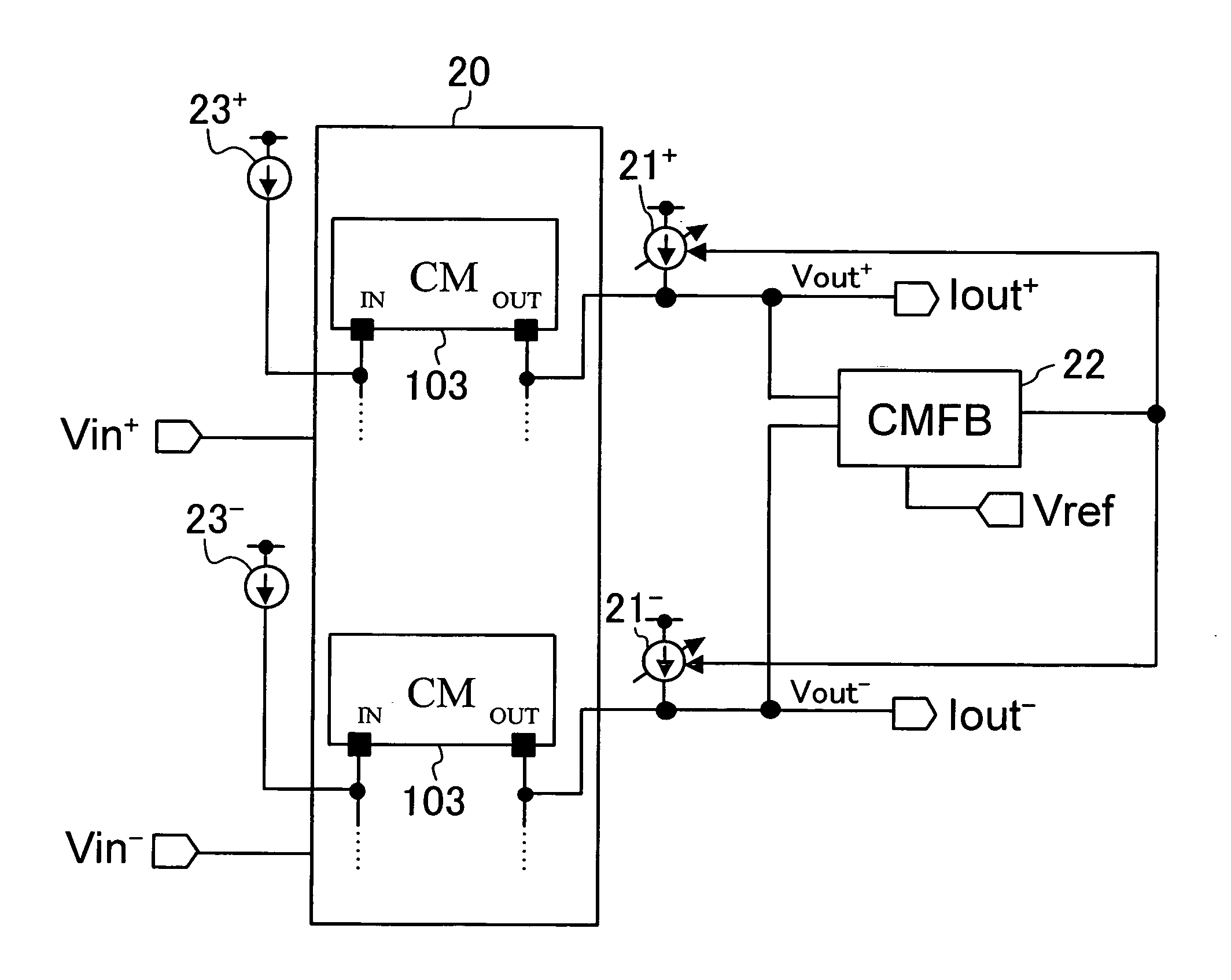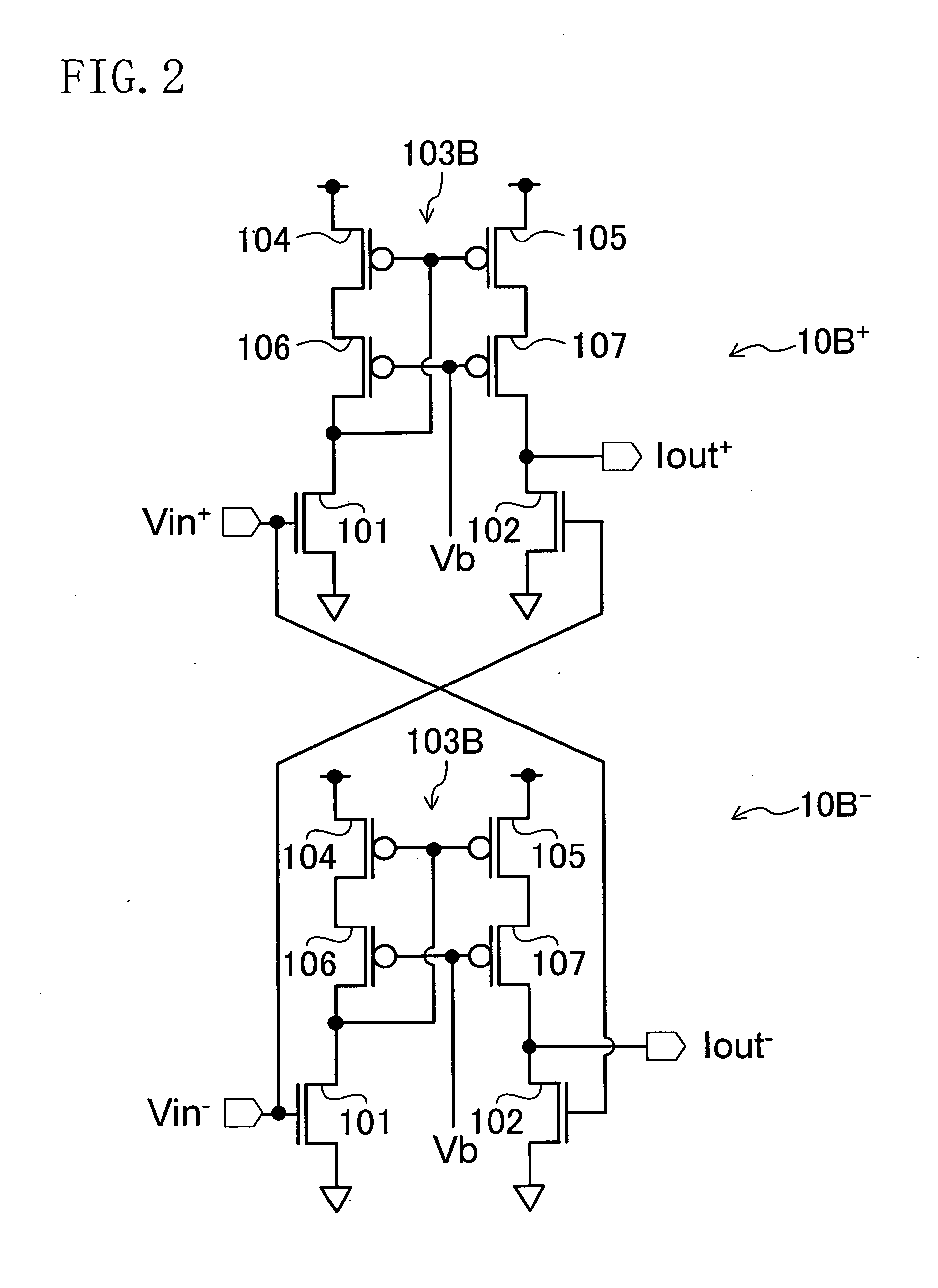Transconductor, integrator, and filter circuit
a filter circuit and integrator technology, applied in the field of transconductor, can solve the problems of increasing chip area and power consumption, low-power complex filter, and increasing common-mode potential, so as to reduce power consumption and chip area, and improve noise characteristics
- Summary
- Abstract
- Description
- Claims
- Application Information
AI Technical Summary
Benefits of technology
Problems solved by technology
Method used
Image
Examples
first embodiment
[0046] (First Embodiment)
[0047]FIG. 1 illustrates a configuration of a transconductor according to a first embodiment. This transconductor comprises transconductors 10A+ and 10A− each of which receives a differential voltage signal and outputs a single-end current signal. An inversion input terminal of one of the transconductors 10A+ and 10A− is connected with a non-inversion input terminal of the other. Differential voltage signals (Vin+-Vin−) and (Vin−-Vin+) are input to the input transconductors 10A+ and 10A−, respectively. Current signals Iout+ and Iout− are output from single-end output terminals of the transconductors 10A+ and 10A−, respectively.
[0048] Specifically, the transconductor 10A (a superscript is removed when the transconductors 10A+ and 10A− are not distinguished from each other, and the same applies to the other reference characters) comprises transistors 101 and 102 (voltage-to-current conversion circuits) and a current mirror circuit 103A. The current mirror cir...
second embodiment
[0055] (Second Embodiment)
[0056] In the transconductor of the first embodiment, for example, as illustrated in FIG. 1, the transistors 101 and 102 having the pseudo-differential configuration are used to perform voltage-to-current conversion. Therefore, the gm value of the transconductor is equal to the gm value of each of the transistors 101 and 102. In other words, the gm value of the transconductor of the first embodiment is influenced by the common-mode operating point of the differential voltage signal (Vin+-Vin−). More specifically, an operating point of the differential output of the transconductor of the first embodiment varies depending on ambient temperature, a power supply voltage, a process variation, and the like as well as an input operating point. A change in the output operating point particularly causes a deterioration in characteristics of applications in which a plurality of transconductors are connected in cascade, such as, for example, a Gm-C filter as illustrat...
third embodiment
[0067] (Third Embodiment)
[0068] An integrator is constructed by adding a capacitor to the transconductor of each embodiment above. For example, in the case of the transconductor of FIG. 4, there are three portions to which a capacitor is connected: between the differential output terminals; between the differential output terminal and the output terminal of the common-mode feedback circuit 22; and between the input and output terminals of the current mirror circuit 103. FIG. 6 illustrates a configuration of an integrator according to a third embodiment. This integrator is obtained by adding capacitors 31, 32+ and 32−, and 33+ and 33− to the above-described three portions of the transconductor of FIG. 4. The capacitor 31 is connected between the differential output terminals of the transconductor. The capacitors 32+ and 32− are each connected between the differential output terminal and the output terminal of the common-mode feedback circuit 22. The capacitors 33+ and 33− are each co...
PUM
 Login to View More
Login to View More Abstract
Description
Claims
Application Information
 Login to View More
Login to View More - R&D
- Intellectual Property
- Life Sciences
- Materials
- Tech Scout
- Unparalleled Data Quality
- Higher Quality Content
- 60% Fewer Hallucinations
Browse by: Latest US Patents, China's latest patents, Technical Efficacy Thesaurus, Application Domain, Technology Topic, Popular Technical Reports.
© 2025 PatSnap. All rights reserved.Legal|Privacy policy|Modern Slavery Act Transparency Statement|Sitemap|About US| Contact US: help@patsnap.com



